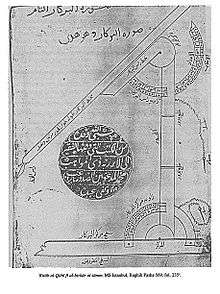Alhazen's problem
The medieval mathematician Ibn al-Haytham (Alhazen) solved an important problem known as Alhazen's problem in his work on catoptrics in Book V of the Book of Optics . The problem was first formulated by Ptolemy in 150 AD.[1]
Geometric formulation
The problem comprises drawing lines from two points in a circle meeting at a third point on its circumference and making equal angles with the normal at that point. This is equivalent to finding the point on the edge of a circular billiard table at which a cue ball at a given point must be aimed in order to carom off the edge of the table and hit another ball at a second given point. Thus, its main application in optics is to solve the problem, "Given a light source and a spherical mirror, find the point on the mirror where the light will be reflected to the eye of an observer." This leads to an equation of the fourth degree.[2][3][1]
Sums of powers
Ibn al-Haytham eventually derived a formula for the sum of fourth powers, where previously only the formulas for the sums of squares and cubes had been stated. His method can be readily generalized to find the formula for the sum of any integral powers, although he did not himself do this (perhaps because he only needed the fourth power to calculate the volume of the paraboloid he was interested in). He used his result on sums of integral powers to perform what would now be called an integration, where the formulas for the sums of integral squares and fourth powers allowed him to calculate the volume of a paraboloid.[4]
Influence
Ibn al-Haytham solved the problem using conic sections and a geometric proof, but later mathematicians such as Christiaan Huygens, James Gregory, Guillaume de l'Hôpital, Isaac Barrow, and many others, attempted to find an algebraic solution to the problem, using various methods, including analytic methods of geometry and derivation by complex numbers.[5] An algebraic solution to the problem was finally found in 1997 by the Oxford mathematician Peter M. Neumann.[6] Recently, Mitsubishi Electric Research Labs researchers solved the extension of Alhazen's problem to general rotationally symmetric quadric mirrors including hyperbolic, parabolic and elliptical mirrors.[7] They showed that the mirror reflection point can be computed by solving an eighth degree equation in the most general case. If the camera (eye) is placed on the axis of the mirror, the degree of the equation reduces to six.[8] Alhazen's problem can also be extended to multiple refractions from a spherical ball. Given a light source and a spherical ball of certain refractive index, the closest point on the spherical ball where the light is refracted to the eye of the observer can be obtained by solving a tenth degree equation.[8]
References
- 1 2 Weisstein, Eric. "Alhazen's Billiard Problem". Mathworld. Retrieved 2008-09-24.
- ↑ O'Connor, John J.; Robertson, Edmund F., "Abu Ali al-Hasan ibn al-Haytham", MacTutor History of Mathematics archive, University of St Andrews.
- ↑ MacKay, R. J.; Oldford, R. W. (August 2000), "Scientific Method, Statistical Method and the Speed of Light", Statistical Science, 15 (3): 254–278, doi:10.1214/ss/1009212817, MR 1847825
- ↑ Victor J. Katz (1995), "Ideas of Calculus in Islam and India", Mathematics Magazine68 (3): 163–174 [165-9 & 173-4]
- ↑ Smith, John D. (1992). "The Remarkable Ibn al-Haytham". The Mathematical Gazette. 76 (475): 189–198. doi:10.2307/3620392.
- ↑ Highfield, Roger (1 April 1997), "Don solves the last puzzle left by ancient Greeks", Electronic Telegraph, 676, archived from the original on November 23, 2004, retrieved 2008-09-24
- ↑ Agrawal, Amit; Taguchi, Yuichi; Ramalingam, Srikumar (2011), Beyond Alhazen's Problem: Analytical Projection Model for Non-Central Catadioptric Cameras with Quadric Mirrors, IEEE Conference on Computer Vision and Pattern Recognition
- 1 2 Agrawal, Amit; Taguchi, Yuichi; Ramalingam, Srikumar (2010), Analytical Forward Projection for Axial Non-Central Dioptric and Catadioptric Cameras, European Conference on Computer Vision
